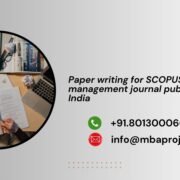Paper writing for SCOPUS management journal publication India
Paper writing for SCOPUS management journal publication India
Paper writing for SCOPUS management journal publication India. In India’s dynamic academic ecosystem, SCOPUS-indexed management journal publication has become a vital benchmark of scholarly excellence. For MBA scholars, PhD researchers, and faculty members, publishing in SCOPUS management journals is more than an academic requirement—it’s a gateway to global recognition, career advancement, and research credibility.
At our professional research and writing support service, we offer comprehensive paper writing and publication assistance for SCOPUS management journals in India, ensuring your work meets international academic and publication standards.
Why Publish in SCOPUS-Indexed Management Journals?
SCOPUS, managed by Elsevier, is the largest and most reliable database for peer-reviewed research publications. It evaluates journals based on research quality, impact factor, and citation index, making SCOPUS publication a prestigious milestone for every management scholar.
Publishing in a SCOPUS management journal helps researchers:
-
Build a strong academic profile recognized globally.
-
Enhance PhD thesis or MBA dissertation value.
-
Meet UGC and NAAC publication requirements.
-
Qualify for international collaborations and funding opportunities.
-
Gain credibility among industry and academic peers.
In the context of Indian academia, SCOPUS publication is now considered essential for university promotions, PhD evaluations, and global academic ranking compliance.
Professional SCOPUS Management Paper Writing Services in India
Our specialized SCOPUS management paper writing services are designed for scholars who aim for top-tier journal acceptance. We combine academic precision, data-driven analysis, and journal-specific formatting to ensure your manuscript stands out in the peer-review process.
1. Research Topic Selection and Gap Analysis
We help you select innovative, high-impact topics in management areas like marketing, strategy, finance, operations, HR, and entrepreneurship.
Our experts conduct a literature gap analysis using SCOPUS and ABDC databases to identify emerging research areas aligned with your specialization.
2. Conceptual Framework and Research Design
Every successful management paper begins with a robust conceptual model. We develop your research framework, objectives, and hypotheses based on contemporary theories and case studies, ensuring originality and theoretical depth.
3. Data Collection and Empirical Analysis
We assist in both primary and secondary data collection, using advanced statistical tools such as SPSS, AMOS, SmartPLS, R, and Python.
Our analysts interpret findings with clarity, ensuring your study meets the empirical standards required by SCOPUS journals.
4. Manuscript Drafting and Formatting
Our writers prepare publication-ready manuscripts following international academic standards. Every section—from abstract to conclusion—is developed with precision:
-
Title and Abstract: Clear, keyword-optimized, and journal-aligned.
-
Literature Review: Comprehensive coverage of recent SCOPUS references.
-
Methodology: Transparent design ensuring replicability.
-
Results and Discussion: Data interpretation with theoretical insights.
-
Conclusion: Future implications and managerial recommendations.
We also ensure your paper adheres to APA, Harvard, or Elsevier formatting styles, depending on journal requirements.
5. Proofreading, Editing, and Plagiarism Checking
Before submission, each manuscript undergoes professional proofreading and academic editing.
We use Turnitin and Grammarly Premium to guarantee:
-
Plagiarism below 10%
-
Error-free writing
-
Academic tone and coherence
-
Citation accuracy
6. Journal Selection and Submission Assistance
We shortlist suitable SCOPUS-indexed management journals based on your topic, quality (Q1–Q4 ranking), and publication timeline.
Our submission support includes:
-
Journal matching and recommendation
-
Cover letter drafting
-
Submission process management
-
Reviewer response and revision assistance
Popular Management Areas Covered for SCOPUS Paper Publication
Our service supports publication across all key management disciplines, including:
-
Strategic Management and Corporate Leadership
-
Human Resource Management (HRM)
-
Financial Management and Corporate Governance
-
Marketing and Consumer Behaviour
-
Operations and Supply Chain Management
-
Entrepreneurship and Start-up Ecosystems
-
Business Analytics and Artificial Intelligence in Management
-
Sustainability, CSR, and Green Business Models
Each discipline demands specific methodologies and journal targeting strategies, which our subject-matter experts handle with precision.
Advantages of Professional SCOPUS Paper Writing in India
1. High-Quality Academic Content
All papers are written by PhD-qualified management professionals who understand academic integrity, research methods, and publication protocols.
2. Increased Acceptance Rate
With expertise in journal guidelines and reviewer expectations, our papers have a higher probability of being accepted in reputed SCOPUS-indexed journals.
3. Time-Saving and Efficient
We manage the entire process—from topic selection to submission—allowing you to focus on your studies, teaching, or professional work.
4. Ethical and Confidential Writing
We follow strict confidentiality protocols and ensure authorship integrity, guaranteeing that your research remains 100% yours.
5. Affordable Pricing with Global Quality
Our services are cost-effective for Indian researchers without compromising on academic excellence and international standards.
Trusted by Leading Indian Universities
Our SCOPUS management publication support has benefited researchers from top institutions such as:
We have successfully helped numerous scholars publish their management papers in Q1–Q3 SCOPUS journals, enhancing their global research presence.
How to Start Your SCOPUS Paper Publication Journey
- Share your research idea or topic with our team.
- Get a consultation from our SCOPUS publication experts.
- Receive a proposal with potential journal recommendations.
- Approve the plan and start your research paper writing process.
- Review, finalize, and submit your paper for publication.
Our step-by-step support system ensures a smooth journey from conceptualization to final acceptance in a reputed SCOPUS-indexed management journal.
Conclusion
Publishing in a SCOPUS-indexed management journal in India is a mark of academic excellence and credibility. It not only strengthens your research portfolio but also opens doors to career growth, global recognition, and academic success.
Our SCOPUS management paper writing service in India provides complete, ethical, and expert assistance tailored to your research goals. Whether you are a student, faculty member, or corporate researcher, we ensure that your paper meets the highest standards of international publishing.
Thank you for reading our Blog “Paper writing for SCOPUS management journal publication India”.
Also, read our more BLOG here.
For Order “SCOPUS journal ” feel free to contact us at Mob: Call / WhatsApp: +91.8013000664 || Email: info@mbaprojects.net.in














